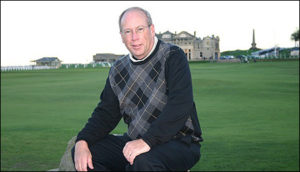by Ron Read
It’s hard to fully describe the pleasure of working with thousands of volunteers in my 43 years in golf. They gave their time and resources to the Game of Golf, usually for one reason – their love for their pastime.
I saw and felt that love at over 100 national championships, plus countless state, regional and qualifying events. If there’s another game that attracts more dedicated volunteers, I haven’t seen it. Every one of those volunteers matter. The reality is that the staggering purses on professional tours wouldn’t be possible without volunteers. In the U.S. alone, my guess is they number more than 100,000 volunteers, all giving back to the game.
Many volunteers have stood out over the years. Some of those became close, personal friends.
And so it is with a heavy heart that I’m sharing about just one volunteer – Bob Hollister. Bob passed away last Friday evening near Tacoma, Wash. (Click here to see Hollister’s obituary.)
We met in 1984. At the time, Bob was general manager of Tacoma Country and Golf Club. Founded in 1894, it is the oldest club in the West, and it had a wonderful tradition of hosting national amateur championships. Bob had engineered the hosting of the 1984 U.S. Senior Women’s Amateur, held at the club. Tony Zirpoli of the USGA and I conducted the event with a partnership that was in place then, of USGA and club volunteers. In the end, the key player was Bob Hollister. He was everywhere, all week, doing everything. His style was low key. I later told him that he should have been a mortician. Nothing seemed to bother Bob. No matter what the task, he made sure it was done.
Given our observations, we invited Bob to serve on the USGA’s Regional Affairs Committee (RAC). He was, I believe, the first club manager ever to serve on that committee. He served on the RAC for about 30 years. He was a gift to golf, one that kept on giving, endlessly, and he did so for all the right reasons. Not once did he ever seek credit.With Tacoma Country and Golf Club approaching its centennial year, Bob sought to make that year even more special for his club. He convinced the board to invite the USGA for the 1994 U.S. Women’s Mid-Amateur. Once again, Bob delivered, and his club added to its storied history of supporting Amateur golf. In fact, I can’t think of a more generous club.
With Tacoma Country and Golf Club approaching its centennial year, Bob sought to make that year even more special for his club. He convinced the board to invite the USGA for the 1994 U.S. Women’s Mid-Amateur. Once again, Bob delivered, and his club added to its storied history of supporting Amateur golf. In fact, I can’t think of a more generous club.
After 18 years, at Tacoma Golf and Country Club, Bob accepted a new challenge. He became general manager at Sahalee Country Club, east of Seattle. He brought with him the spirit of giving back to golf. Sahalee hosted the 1998 PGA championship, then the 2002 WGC-NEC Invitational. And just prior to his moving on to become general manager at nearby Overlake Golf and Country Club, Bob took my call.
“Bob, we need a site for the 2010 U.S. Senior Open, BADLY!” Within a month, he had convinced the Sahalee Country Club board to extend that invitation. Then he moved on to his new assignment at Overlake. (Bob and I later attended this U.S. Senior Open not as staff, rules officials, or volunteers, but as spectators, knowing the roles we had played in this highly successful event.)
Bob ended his career last year at Wing Point Golf and Country Club on Bainbridge Island near Seattle. Before retiring, he oversaw the Wing Point’s clubhouse renovation. In our 33 years of friendship, Bob oversaw major clubhouse renovations at four prestigious clubs. He always left clubs better than when he arrived.
Bob was a master at dealing with boards and staff. This staffer never worked with a better manager or one who served his club in a more professional, low-key manner. We laughed at the moniker I gave him – The Mortician.
We laughed on many occasions, mostly at my mistakes. Bob volunteered for many U.S. Opens at which I was assigned, starting duty on the first tee. He had a difficult assignment – trying to make me look good, usually after one of my gaffes. He was my go-fer, chasing down Hole Location sheets when we’d run out, replenishing scoring pencils or finding lost scorecards. Sometimes, he herded players and volunteer scorekeepers to prevent them from arriving late to the first tee, usually because of large crowds.
We had a light moment in 2004 U.S. Open at Shinnecock Hills. We had a special guest on the first tee. Prince Andrew, captain of the Royal & Ancient Golf Club of St Andrews, was assigned as a Special Observer with the final pairing. The Prince was attending the U.S. Open unannounced, and he roamed the grounds anonymously. Few even knew he was in attendance. He arrived for his assignment early, and I introduced him to players in the final group – South Africans Ernie Els and Retief Goosen. They were clearly surprised by the appearance of royalty.
In response to meeting the players, the Prince humbly introduced himself simply by saying, “Hello, I’m Andrew.”
Bob had observed all this, but had yet to meet the Prince. When I finally had the chance to introduce Bob, he started to say to the Prince, “I’m sorry….I didn’t catch….”
I had anticipated what was on Bob’s mind, and my elbow may have struck him between ribs three and four. Bob “got” the message and stopped his comment.
After formal introduction of players and officials to the world – TV and gallery – Bob and I had a good laugh. Then we looked at each other.
“What IS his last name?” I asked.
He came up with the answer, “WINDSOR!”
Bob’s counsel was always invaluable. He and his wife, Jen, lived in Steilacoom, Wash., just a few miles south of Chambers Bay. He kept me informed on a variety of local issues – course conditions at Chambers Bay and other issues, often political. He did so through the 2010 U.S. Amateur (held at Chambers Bay) and until my departure from the USGA in 2013. He was uncannily accurate in his assessments. I never found him wrong.
Bob Hollister knew what he knew. Equally important, he knew what he did not know. His counsel was invaluable.
Along the way, I inducted Bob into my personal Hall of Fame.
Playing the (then) par-3, 11th hole at The Home Course near Chambers Bay, we both hit excellent tee shots. Both balls disappeared. We were uncertain of the outcome, but we thought one might be a “1”. Well, there was. HIS! I lost the hole with a birdie 2.
Truth is, he was always better at everything, always modestly and quietly, and with the Midas touch.
Ron Read was the USGA Western Regional Director for many years, and for 22 years (1989-2010) was the starter on the first tee of the U.S. Open.

